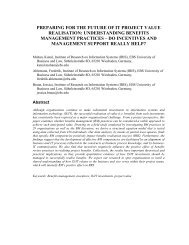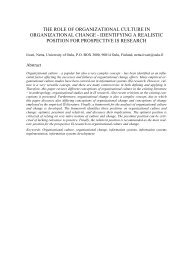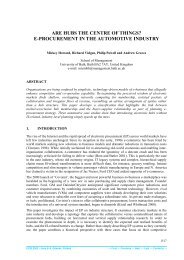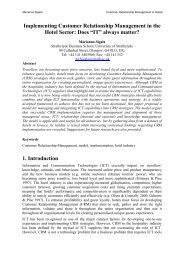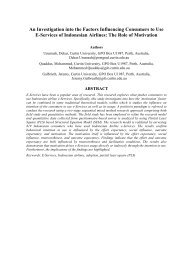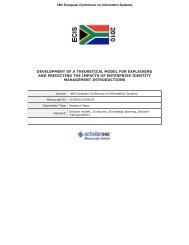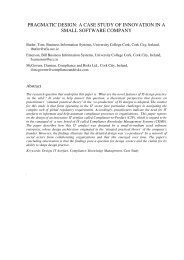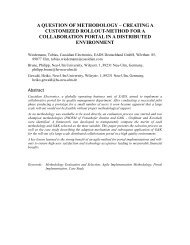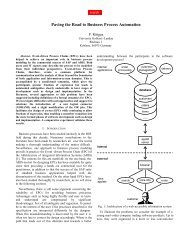enforcing information security policies through cultural boundaries
enforcing information security policies through cultural boundaries
enforcing information security policies through cultural boundaries
You also want an ePaper? Increase the reach of your titles
YUMPU automatically turns print PDFs into web optimized ePapers that Google loves.
1 Introduction<br />
Today, ensuring availability, integrity and confidentiality of <strong>information</strong> and data concerns many<br />
organizations. Deterrence can be one of the initial steps that organizations can take to ensure<br />
<strong>information</strong> <strong>security</strong> (Straub and Welke, 1998). However, successful deterrence depends on<br />
organization’s ability to control its environment with respect to internal and external threats.<br />
Information <strong>security</strong> <strong>policies</strong> define the nature of these controls (i.e., technical, formal and informal<br />
controls) and how these controls complement each other (Dhillon, 1999).<br />
Moreover, <strong>security</strong> <strong>policies</strong> govern how organizations’ <strong>information</strong> should be protected (Kabay, 2002;<br />
Barman, 2002). Whitman (2004) posits that a good <strong>security</strong> policy needs to “outline individual<br />
responsibilities, define authorized and unauthorized uses of the systems, provide venues for employee<br />
reporting of identified or suspects threats to the system, define penalties for violations, and provide a<br />
mechanism for updating policy” (p.52). Enforcing corporate <strong>security</strong> <strong>policies</strong> has been reported as one<br />
of the most effective ways to prevent or reduce electronic crime (Gordon et al., 2004). Overall,<br />
<strong>security</strong> <strong>policies</strong> can be considered as guidelines and can be used as a starting point for creating a<br />
<strong>security</strong> structure within an organization (Whitman, 2004).<br />
The nature of multinational companies (MNCs) adds a layer of complexity to <strong>enforcing</strong> <strong>security</strong><br />
<strong>policies</strong> because MNCs need to consider the effects of different <strong>cultural</strong> and organizational settings<br />
and integrate these in their corporate <strong>security</strong> <strong>policies</strong>. Basing his arguments on Hofstede’s <strong>cultural</strong><br />
dimensions, Abdul-Gader (1997) emphasized culture as one of the most important environmental<br />
factors that MNCs should consider while adopting global Information Systems (IS) <strong>policies</strong> in Arab<br />
Gulf countries. He postulated that misconceptions of understanding about fate in the Islamic context<br />
and the technical capability of the Arab language are some of the issues that need to be considered by<br />
MNCs. However, management practices do not have to be different just because subsidiaries and<br />
parent company are in different countries and <strong>cultural</strong> settings. In their study, for instance, Anakwe et<br />
al. (2000) concluded that organizational support enhances microcomputer usage in Nigeria. Their<br />
result found support in other studies which demonstrated that similar management practices can be<br />
effective in different <strong>cultural</strong> settings (Igbaria, et al. 1995; Igbaria, 1992).<br />
Although practitioners continuously emphasize the importance of <strong>security</strong> <strong>policies</strong>, IS scholars have<br />
not paid the required attention to this context from the cross-<strong>cultural</strong> perspective. For instance, in their<br />
citation analysis of IS articles, Ford et al. (2003) found 57 articles about various contexts of IS that<br />
cited Hofstede’s research on national culture. Further analyses showed that IS Management area led<br />
with 25 articles. Within this research stream, however, no study cited Hofstede’s work in the IS Risk<br />
Management context.<br />
We aim to fulfil this gap by looking at <strong>cultural</strong> and institutional differences of an MNC and its<br />
subsidiaries and by investigating how these differences affect the MNC’s strategy to enforce corporate<br />
<strong>security</strong> <strong>policies</strong> to its subsidiaries in different <strong>cultural</strong> settings. More specifically, we will discuss<br />
<strong>cultural</strong> distance, institutional distance, and the stickiness of the knowledge transfer and offer series of<br />
propositions. Our goal is to make a unique contribution to the IS <strong>security</strong> literature by focusing on the<br />
issues to be considered while <strong>enforcing</strong> <strong>information</strong> <strong>security</strong> <strong>policies</strong> within the MNC framework.<br />
2 Theoretical Framework<br />
According to Minbaeva et al. (2003), MNCs can develop knowledge in one location and exploit it in<br />
another location <strong>through</strong> internal transfer of knowledge. One way of creating competitive advantage<br />
for MNCs is effectively sharing organizational practices (Jensen and Szulanski, 2004). For example, in<br />
the strategy literature, organizational practices and routines are considered as important sources of







